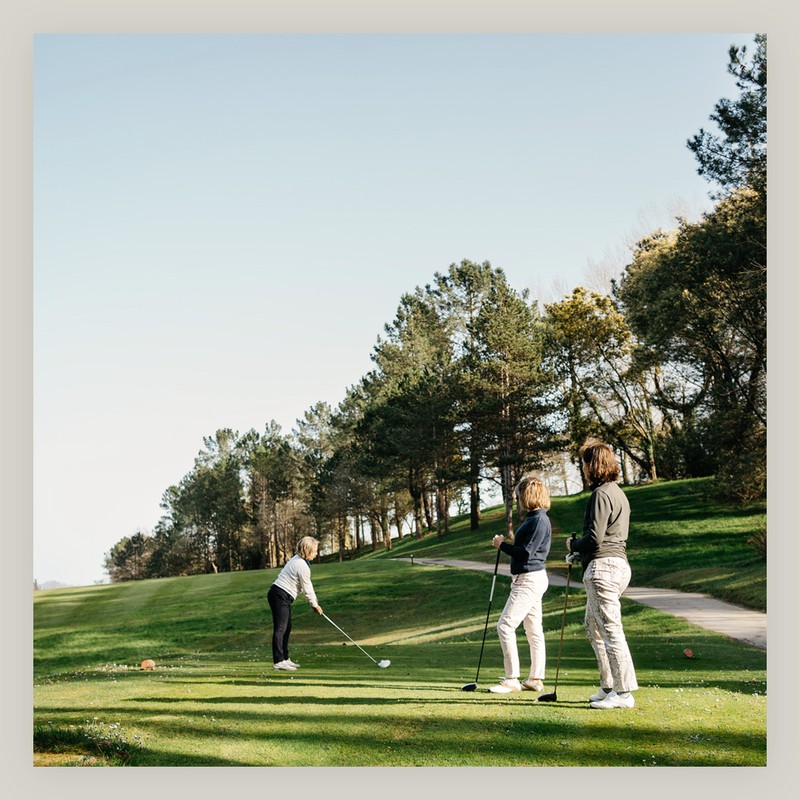
Everything You Need To Know About Playing Golf
First, why might one think about playing golf later in life?
“Golf is a great game for everyone. It’s fun, gets you fit, reduces stress and offers full lungs of fresh air. A round of golf can take you away from the hassles of everyday life and focus your mind. And it’s great for having a laugh with friends and making new ones. The famous 19th hole is a place to enjoy a drink, discuss your game and meet your future opponents. At England Golf, we truly believe that this is a game for everyone. That’s why we’ve launched Get into Golf. We want to inspire more people to give it a go. Once you try it, we think you’ll want to learn more.” – the England Golf experts
How many women do you see taking an interest in it?
“We always want more women and girls to get into golf. At present, only 15% of club members are female – which means we’re lagging far behind many other European countries. So, what are we doing about it? We’ve got great programmes to attract new players and we’re making a lot of noise about the female side of the game – last year 40% of people taking part in Get into Golf activities were female, so you’ll find plenty of like-minded company. Women-only sessions are available, as well as mixed.” – the England Golf experts
What’s the easiest way to get started?
“Anyone who’s interested in taking up the sport should visit our Club Finder to find taster and beginner sessions near you. Then, get in touch with your local golf club – with our ‘Find and Play’ service you can use our filter to find Get into Golf clubs, which are ready to welcome new players to the game and have more activities for beginners. There are usually great value group sessions on offer, too, which make it easy to meet other people, just like you, who are starting out.
We know it can be daunting at first and that’s why we also run Women on Par. These are fun playing days for women beginners, designed to help build confidence, make friends – and have a laugh together. We ignore traditional scoring and ask you to complete a set of challenges instead – and we finish with a glass of fizz or juice.” – the England Golf experts
Any specific tips for beginners?
“We know golf can be scary for new players. There’s so much to think about from ‘what do I wear’, to ‘will I hit this ball’ and ‘is anyone watching me?’ So, here are some hints and tips to help you get started. First, learn to play with a professional coach. Alternatively, try group lessons – they’re a great way to meet other beginners, make new friends and have a laugh. Get on the practice ground or driving range to practise your swing – it’s an amazing feeling when the ball soars up and away. And don’t forget to practise your putting. There’s a lot of truth in the old saying ‘drive for show and putt for dough’. Also, do some research about golfing etiquette, and wear comfortable clothes which are easy to move in. Finally, try keeping a golfing diary – it’ll be fun to look back on your progress.” – the England Golf experts
Can you tell us anything about the basic rules?
“The good news is the rules have actually changed to make the game easier to understand and more welcoming for new players. Your best bet is to read the official 2019 Rules of Golf at The R&A website.” – the England Golf experts
And what about the cost – is it an expensive hobby?
“The cost of a 30-minute golf lesson will be between £20-£30. If you are just getting started, you’ll probably need anything between three to five lessons in the first six months. Then, while you go to your lessons to learn, you need to back that up with hours at the driving range to practise. The driving range will cost between £5-£10 per trip. If you don’t own your own golf clubs, you’ll need to factor in an extra few quid for club hire, too. Based on the above, you’re likely to spend around £250 in the first six months learning how to play.” – Mark Stevenson, Go And Golf
And what about membership fees – how steep can they be?
“Once you are hooked on the game and enjoy playing weekly or monthly, it may make more sense for you to become a member at a private club or a group of golf courses. In this situation, you can expect to pay a monthly or annual fee for unlimited golf. A golf membership will typically cost anywhere from £500 to £2,000 per year. However, the decision between paying green fees or becoming a member of a golf club comes down to how frequently you play and whether you want the added benefits of joining a club. This will vary, but once you are a member you should have access to play in tournaments, a range of practice facilities, and sometimes other additions too. If this appeals to you then it may be worth becoming a member of a golf club, but it won’t be right for everyone.” – Mark Stevenson, Go And Golf
Do you have any advice for buying a set of clubs?
“Buying new golf clubs can be both intimidating and scary, especially for a beginner. There are so many options, and you can be shocked by the cost. Ultimately, you will end up with 14 clubs – a combination of woods, irons, wedges, and a putter. The good news is you don’t have to buy them all at once; you can build out your set over time. Like anything, you can buy budget versions or premium versions and a set of clubs can cost anywhere between £200 to £5,000. But in order to play, you will need golf balls, too. When you first start to play on a golf course, you’re probably going to lose a few balls each round. So, at the beginning of your golf career, the balls you buy should be about quantity, not quality. Prices for a dozen golf balls start at around £10.” – Mark Stevenson, Go And Golf
Any budgeting tips you might be able to share?
“Look for group lessons with a teacher – they will be cheaper, and you may meet some other people who are just getting started as well. Do some research on free lessons for beginners, too – you may be able to find a free lesson that a local course is hosting to help grow the sport. Alternatively, buy a package of lessons – you may be able to negotiate a lower price if you buy more than one lesson at once. You can also use YouTube videos and experienced friends to learn the basics, but this will almost definitely increase the time it takes you to learn and improve. Most driving ranges will also offer discounts if you purchase in bulk or join as a member – if you know you are going to visit once a week, you might as well buy their multi-visit plans. Finally, invest time in improving your short game (putting and chipping) – you should be able to find a place to do this for free.” – Mark Stevenson, Go And Golf
In the midst of the pandemic, can older people head to the course like normal?
“Yes – but this decision is down to the individual golfer based on their own circumstances. If you are living in a household with a possible Covid-19 infection, or if you are classified as extremely vulnerable on health grounds, the current guidance is that you should remain at and exercise at home.” – the England Golf experts
So, when will it be possible to head down to a course again?
“From 29th March, the ‘rule of six’ came into force again in England. However, there are a limited number of exceptions when it comes to group gatherings. For example, people who provide essential support (e.g. carers) to golfers with a disability are exempt and do not count towards the maximum number of six people in a group of golfers (i.e. four golfers and two caddies). Groups of six people may be made up of individuals from different households, too. If you want more information, download this helpful cheat sheet.” – the England Golf experts

The team from Penmaenmawr Golf Club share their thoughts…
General Well-Being
The game of golf is wonderful for the psyche. It keeps the mind alert and provides vital human contact, along with several other benefits to all-round health.
Socialising
As well as being a competitive sport (if you want it to be), playing golf can be a great social activity. You’ll find most modern golf clubs are welcoming to new members, with plenty of experienced players happy to pass on tips and hints to beginners. The golf clubhouse is usually a venue for socialising, as well as meeting people with a variety of lifestyles and making new friends.
Reducing Stress & Anxiety
Just a good walk in the fresh air does wonders for endorphin and serotonin levels, leading to improved mood and reduced levels of stress and anxiety. Coupled with an escape from the hassles of day-to-day living, the game can provide great relaxation.
Maintaining Mental Alertness
Weighing up the risk/reward elements of a particular shot, totting up scores and the other various facets of the game all aid in keeping the mind sharp.
Upping Physical Fitness
Aside from mental health considerations, a round of golf can form a superb part of a physical fitness programme, for players of every age and both sexes. Along with the amount of walking involved, the golf swing in itself is great for providing a full-body workout. Each full swing exercises arms, legs, back and abdomen, with numerous repetitions over the course of a round – approximately 30 plus times for accomplished players and many more for novice golfers. Attempting to improve your skills levels by practising on the range provides great exercise, but a word of warning to beginners – you might find your hands blister easily…
Losing Weight
A full, 18-hole round of golf involves a walk of around five to six miles. Even on a flat course, this equates to expending around 1,500 calories and even more if the course is particularly undulating. The less energetic players, who choose to ride in a golf buggy rather than walking or wish to play a shortened round of nine holes, will still expend more calories than a strenuous, lengthy gym workout.
Sticking To Low Impact
Golf is what’s known as a ‘low-impact’ sport. As a result, joints are not subject to the stresses and strains of more energetic activities like tennis and running, which can lead to long-term joint damage. This makes golf an ideal activity for older players, who, perhaps unable to throw rugby balls around as they did in their younger years, can still enjoy this wonderful sporting activity.
For more information on getting started with golf visit EnglandGolf.org, GoAndGolf.co.uk and PenGolf.co.uk.
DISCLAIMER: Features published by SheerLuxe are not intended to treat, diagnose, cure or prevent any disease. Always seek the advice of your GP or another qualified healthcare provider for any questions you have regarding a medical condition, and before undertaking any diet, exercise or other health-related programme.
DISCLAIMER: We endeavour to always credit the correct original source of every image we use. If you think a credit may be incorrect, please contact us at info@sheerluxe.com.

